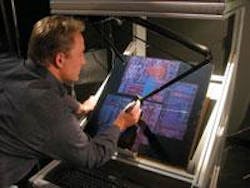HOLOGRAPHY: Holographic imagery enters the industrial mainstream
Robin Curle, CEO of Zebra Imaging (Austin, TX), and her associates, whether engineers, managers, investors or advisors, are determined to turn the elusive hologram into a reliable commercial and industrial tool.
The hologram concept is almost six decades old, while the laser technology that brought the hologram to life has been around for more than four decades. But although holography has attracted a lot of attention, it has mostly managed to escape widespread commercial exploitation. (Embossed holograms, used on everything from credit cards to cereal-box toys, are a major exception.)
Six years ago, Zebra Imaging founders Mark Holzbach, Michael Klug, and Alejandro Ferdman, along with their team of scientists, made a holographic image big and substantial enough to serve as a 3-D full-color 50%-scale model of a Ford concept car (see Laser Focus World, February 1999, p. 14). Now, Curle’s corporate team is investing the founders’ original technical wizardry with the high resolution, fast turnaround times, and snappy cost points required for applications ranging from automotive and architectural design to military mapping and medical imaging. The first two production systems went online this spring.
The rise of the hogel
Curle differentiates Zebra’s computer-generated holographic images from the photographic holograms generated directly from a physical object, however. As with the 2-D pixels in a digital image, Zebra’s holograms are constructed of thousands of holographic pixels, referred to as hogels—unique to Zebra’s technology. The prototype system that modeled the Ford concept car was a “slow color imager,” according to Curle, because it took from one to four days to convert CAD data into 2-mm hogels and to assemble tens of thousands of hogels into 2 × 2-ft holographic tiles. Several tiles were required to create a full-size holographic image of an automobile.
In addition to the time required for construction, shortcomings of the original prototype included a lack of the fine detail needed for industrial-design work because the hogels were too large. So the current generation of holographic imagers, focused specifically on the needs of automotive, military, and architectural customers, have halved the hogel size to 1 mm, which boosts resolution by a factor of four. They’ve also reduced the time for assembling a 2 × 2-ft tile from three days to 90 minutes by producing what Curle referred to as high-speed monochrome, instead of slow color, imagery.
The color of the monochrome is green—fittingly, perhaps, considering Zebra’s paying customers such as Ford (Dearborn, MI), British Aerospace (Hampshire, England), and DARPA, who tend to be early technology adopters, use lots of 3-D imagery, and also rely on iterative processes that can incorporate holography. In the auto industry, for instance, using holography instead of physical models reduces design time on the order of 85% to 90% and time to the market by about a year, Curle said, “Design costs plummet by about 65%. Zebra has also built a replicator that produces exact copies of 2 × 2‑ft color holographic tiles in only 90 seconds, and a haptics capability enables users to actually touch holographic features using a stylus and interface with the data set from which the holographic image was made (see figure).
The quest is far from over, however. Zebra Imaging is about to release 0.5‑mm hogels to boost resolution by another factor of four. The added resolution is expected to enable Zebra’s beautifully detailed holographic models to take on the precise tolerances of engineering and design applications, and eventually to launch into the next vertical market step, medicine. By this time next year, Zebra is expecting a return to full color at high speed, enabled by laser and engineering improvements now under way.
The roadmap for the next four or five years initially calls for rewritable holographic images that can be refreshed periodically with new data, leading ultimately to interactive, real-time holographic imagery in which the current 95° to 100° full-parallax viewing angles are increased to 180° on faster holographic systems. Currently, the systems operate at 60 Hz, Curle said. But they could easily operate at 1000 Hz once fast liquid-crystal-display panels become commercially available.
Since making the process faster also makes it less expensive, increasing the speed will likely to broaden the base of potential applications. So, who knows, perhaps within less than a decade the once-elusive hologram will find a regular job in the local shopping center-a 3-D version of the photocopy.
About the Author
Hassaun A. Jones-Bey
Senior Editor and Freelance Writer
Hassaun A. Jones-Bey was a senior editor and then freelance writer for Laser Focus World.
